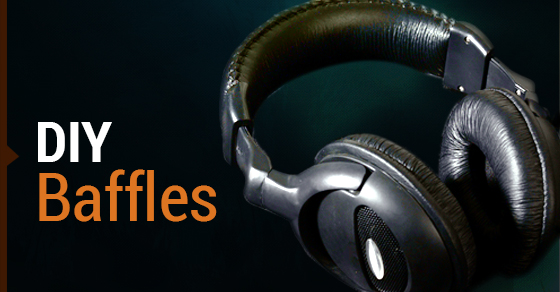To truly make an acoustically balanced recording environment in your studio or recording room, you probably need a certain amount of sound treatment. One of the best and easiest things you can use are sound baffles, which are shaped objects that reduce the volume of any sound that passes through them. A good broadband baffle (meaning it absorbs multiple frequencies to give a linear response) both keeps sound out and keeps the echoes down.

You might have heard that baffles “soundproof” a room, but unfortunately they don’t. A baffle won’t get rid of the ambient sound trickling in from the other parts of the house, but what it will do is absorb the echoes bouncing around the room and give you a much cleaner recorded track.
If you buy prefabricated baffles they can be expensive, but making your own is a cheap and easy alternative, especially if you’ve got some home improvement experience under your belt.
We’ve found that you can build your own acoustic baffles at home for under $6 per square foot that work almost as well as manufactured ones. The best part is that you will still get to use professional materials since it’s the assembly, and not the materials, that make the pro ones so expensive.
Here’s what you need to do:
Building a Baffle
A sound baffle has a few different components: sound absorbing material, wooden frame, fabric cover, and wall hanger.
The best choice for sound absorbing materials is high-density (3-8 lbs) acoustic fiberglass, that’s either 2” or 3” thick. You can buy this online for about $4 a square foot. One of the most popular brands for sound applications is Owens Corning 703. The thicker the insulation in the baffle, the lower it will extend frequency-wise for sound absorption. If you’re only recording higher frequency material such as acoustic guitar and vocals, you can probably get away with 1” thick material, at $2 or $3 per square foot.
Now, surround your sound absorbing material in a wooden frame. You can make this out of any strips of wood and some wood glue. Use a spray adhesive to stick the sound absorbing material in the frame.
Fiberglass is a powerful irritant, so you need to cover it in fabric to prevent its small particles from becoming airborne, but more importantly, you need fabric that won’t reflect sound back out before it gets a chance to be absorbed by the fiberglass. Leather, vinyl and other thick materials are all too sound reflective, so go with light cheap fabrics like burlap and calico. If you can breathe through the fabric, it will transmit sound into the baffle to be absorbed.
Wrap the fabric across the front so that the edges are against the back of the wood frame and staple them there. Make sure to cover the back too by stapling more fabric on the back of the frame as well. If you want your baffles to have a nicer look to them, you can always attach the insulation to a thin plywood backing first, staple the fabric to the edges of the plywood covering the insulation and then add a wood frame around it which you can stain or paint to fit in with the décor of your room.
Finally, attach a heavy-duty wall hanger to the panel frame using wood screws.
Hang a few of these up around your recording space and you’ll be amazed at how much better your track is without all the room reverberation and echoes.
